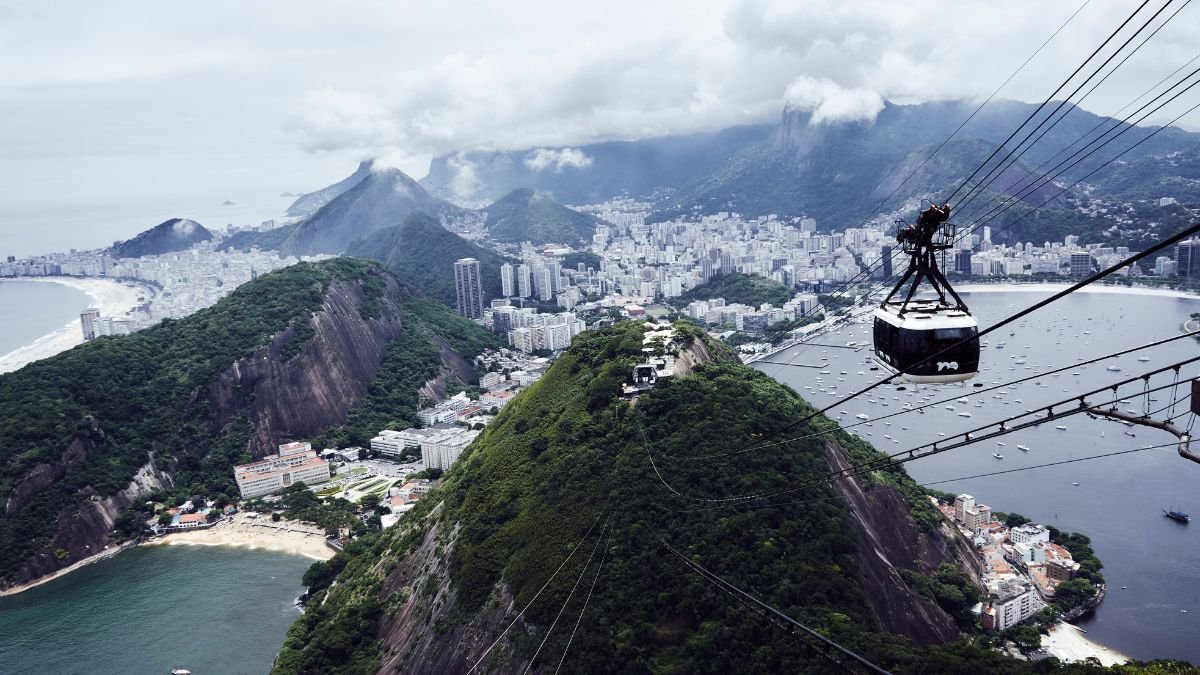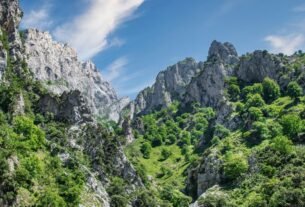Introduction
When you think of Rio de Janeiro, does your mind immediately go to Copacabana Beach? While this iconic spot is undeniably stunning, the city of Rio de Janeiro Brazil offers so much more. Have you ever wondered what lies beyond the postcard-perfect sands?
Rio de Janeiro is a UNESCO World Heritage Site, celebrated for its unique blend of urban energy and natural beauty. From the lush trails of Tijuca National Park to the vibrant streets of Santa Teresa, the city is a treasure trove of experiences waiting to be discovered.
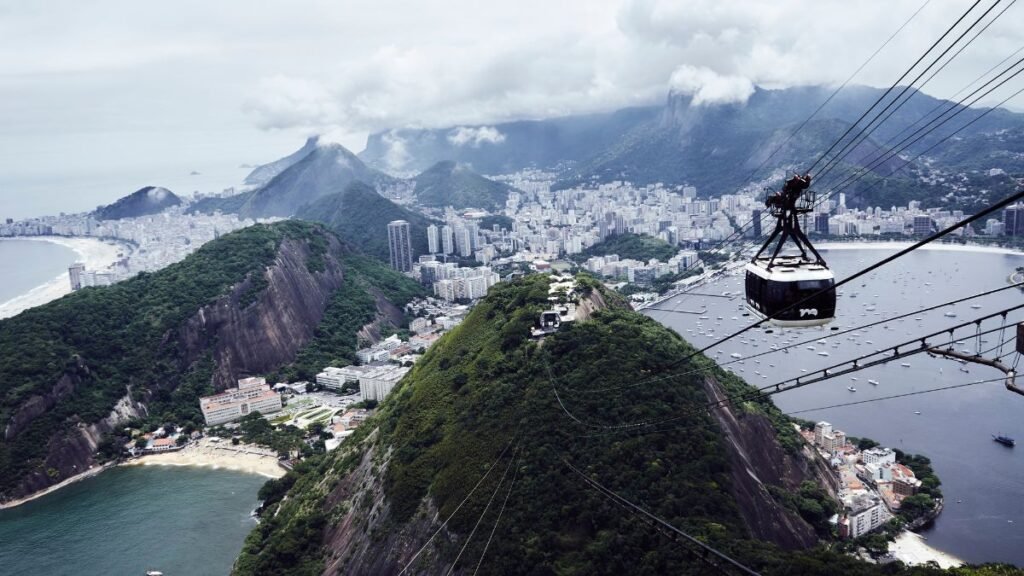
With a population of 6.2 million and a metropolitan GDP of $285.9 billion, Rio is a bustling hub of culture and commerce. It has hosted major global events, such as the 2016 Olympics, and will welcome the 2024 G20 Summit. But beyond the glitz and glamour, there are hidden gems that offer a deeper connection to the city’s soul.
Key Takeaways
- Rio de Janeiro is a UNESCO World Heritage Site, recognised for its rich cultural heritage and landscapes.
- The city boasts a unique blend of urban energy and natural wonders, such as Tijuca National Park.
- With a population of 6.2 million, Rio is a major cultural and economic hub.
- It has hosted global events such as the 2016 Olympics and will host the 2024 G20 Summit.
- Beyond Copacabana, there are numerous lesser-known attractions worth exploring.
Rio de Janeiro Brazil
With a history spanning over 450 years, this city has transformed from a Portuguese colony to a vibrant metropolis. Its unique geography, with elevation variations of 2,329 feet between mountains and sea, makes it a standout destination. Recognised as a UNESCO World Heritage Site since 2012, it’s a blend of natural beauty and urban energy.
Why is it a Must-Visit Destination
This city is not just a tourist hotspot; it’s a cultural and economic powerhouse. As the second-largest GDP contributor in Brazil, it’s home to major corporations like Petrobras and Vale. Its cultural contributions are equally impressive, from samba and bossa nova to the world-famous Carnival.
The local lifestyle, known as “Carioca,” is a unique blend of laid-back charm and vibrant energy. Whether you’re exploring its historic streets or relaxing on its beaches, you’ll feel the city’s pulse.
Beyond Copacabana: Exploring Hidden Gems
While Copacabana is iconic, the city offers so much more. From the lush trails of Tijuca National Park to the artistic streets of Santa Teresa, there’s something for everyone. Its rich history and diverse culture make it a destination that keeps travellers coming back for more.
Christ the Redeemer: Icon of the Marvellous City
Perched atop Corcovado Mountain, the Christ the Redeemer statue is a marvel of engineering and spirituality. Completed in 1931, this 98-foot-tall monument weighs 700 tons and is made of local soapstone and concrete. Its construction was a feat of perseverance, overcoming challenges like transporting materials up the steep mountain.
The statue is more than just a landmark; it’s a symbol of protection and faith. Its outstretched arms are said to embrace the city, offering peace and hope. In 2007, it was named one of the New7Wonders of the world, cementing its place as a global icon.
History and Significance of the Statue
The idea for the statue of Christ was first proposed in the 1850s, but it wasn’t until the 1920s that construction began. The project was a collaboration between Brazilian engineer Heitor da Silva Costa and French sculptor Paul Landowski. The use of soapstone, a durable yet lightweight material, was key to its success.
Religiously, the statue represents Jesus Christ’s love and protection. It’s a beacon of hope for millions, especially during challenging times. Its location on Corcovado Mountain adds to its spiritual aura, offering panoramic views of the surrounding landscape.
Best Times to Visit and Tips for Travellers
To avoid crowds and haze, plan your visit for early morning. The first tram leaves at 8 AM, and the views are clearest at this time. Alternatively, adventurous travellers can hike up the mountain, though this requires stamina and proper gear.
Photography enthusiasts should bring a wide-angle lens to capture the statue and the stunning bay views. For the best lighting, visit during sunrise or sunset. Remember to check the weather forecast, as fog can obscure the view.
Whether you take the tram or hike, visiting Christ the Redeemer is an unforgettable experience. It’s a testament to human creativity and a reminder of the power of faith.
Tijuca National Park: A Natural Wonder of Rio de Janeiro Brazil
Nestled within the city lies a green oasis that feels worlds away from the urban hustle. Tijuca National Park, the world’s largest urban forest, spans 39.58 km² and is a haven for nature lovers. With over 30 waterfalls, 350+ animal species, and lush trails, it’s a must-visit for anyone seeking adventure and tranquillity.
Exploring the World’s Largest Urban Forest
The park’s history is as fascinating as its landscapes. In the 1860s, Emperor Pedro II initiated reforestation efforts to restore the hills that had been cleared for coffee plantations. Today, it’s a thriving ecosystem home to howler monkeys, toucans, and countless other species. The park’s diverse areas include dense forests, cascading waterfalls, and serene chapels.
Hiking Trails and Wildlife Encounters
For hikers, Tijuca National Park offers trails for all skill levels. The Pico da Tijuca trail leads to a summit of 3,350 feet with breathtaking views. Along the way, you’ll encounter the iconic Cascatinha Waterfall and the historic Mayrink Chapel. Wildlife enthusiasts can spot monkeys, butterflies, and rare birds.
While exploring, keep these safety tips in mind:
- Wear sturdy shoes and bring plenty of water.
- Stay on marked trails to avoid getting lost.
- Be mindful of wildlife and maintain a safe distance.
Despite its beauty, the park faces challenges from urban pollution. Efforts are ongoing to protect this natural treasure for future generations. Whether you’re hiking, birdwatching, or simply soaking in the scenery, Tijuca National Park offers an unforgettable escape into nature.
Sugarloaf Mountain: A Panoramic View of Rio
Rising dramatically from the coastline, Sugarloaf Mountain offers a breathtaking perspective of the city. This iconic granite monolith, standing at 1,299 feet, is a must-visit for its stunning views and unique cable car experience. Since its inauguration in 1912, it has welcomed over 60 million visitors, making it one of the world’s top tourist attractions.
Taking the Cable Car to the Summit
The journey to the summit is as memorable as the destination itself. The cable car system, upgraded in 2019 with glass-walled cars called “O bondinho,” provides a thrilling ride with unobstructed views. The two-stage ride takes you first to Morro da Urca and then to the Sugar Loaf summit, offering panoramic vistas of the bay and the surrounding area.
For adventure seekers, the mountain also offers rock climbing opportunities. Its granite formations are a favourite among climbers, providing both challenge and reward.
Sunset Views and Photography Tips
For the best experience, plan your visit during the golden hour. The soft, warm light enhances the natural beauty of the Sugar Loaf, making it ideal for photography. A wide-angle lens is recommended to capture the sweeping views of the bay and cityscape.
Combo tickets are available, allowing you to explore nearby attractions in the Urca neighbourhood. This makes for a full day of adventure and discovery.
Whether you’re a nature lover, photographer, or thrill-seeker, Sugarloaf Mountain promises an unforgettable experience. Its combination of natural beauty and modern engineering makes it a true gem of the world heritage.
Santa Teresa: The Bohemian Heart of Rio
Stepping into Santa Teresa feels like entering a world where art and history collide. This charming neighbourhood, situated on a hill, is renowned for its cobblestone streets and bohemian atmosphere. Once an elite enclave, it has transformed into a thriving culture hub, attracting artists, musicians, and travellers alike.
Art, Culture, and Cobblestone Streets
Santa Teresa’s winding streets are lined with colourful colonial houses and over 200 art studios. The historic tram system, which has been operational since 1896, adds to the area’s old-world charm. Key landmarks, such as Parque das Ruínas and Museu da Chácara do Céu, showcase the neighbourhood’s rich artistic heritage.
The 19th-century aqueduct, now a pedestrian walkway, offers stunning views of the city of Rio de Janeiro. It’s a perfect spot to soak in the area’s unique atmosphere. Whether you’re exploring galleries or strolling through its streets, Santa Teresa is a feast for the senses.
Must-Visit Cafes and Art Galleries
For a taste of local culture, visit Aprazível Restaurant. Its traditional Brazilian dishes and panoramic views make it a favourite among visitors. Boutique hotels like Hotel Santa Teresa offer a cosy stay, blending modern comforts with historic charm.
Art enthusiasts will appreciate the neighbourhood’s vibrant galleries, which showcase works by local and international artists. Don’t miss the chance to explore its hidden gems, from quaint cafes to lively street performances.
While exploring, keep these safety tips in mind:
- Stay on well-lit streets, especially at night.
- Avoid displaying valuables in crowded areas.
- Use trusted transportation options when travelling after dark.
Santa Teresa is more than just a neighbourhood—it’s an experience. Its blend of art, history, and charm makes it a must-visit in the city of Rio de Janeiro.
Parque Lage: A Hidden Oasis in the City
Tucked away in the heart of the city, Parque Lage offers a serene escape from the urban buzz. This 52-acre site is a blend of natural beauty, historic architecture, and vibrant culture. Whether you’re exploring its lush trails or admiring its Italianate mansion, this hidden gem is a must-visit on any list of itineraries.
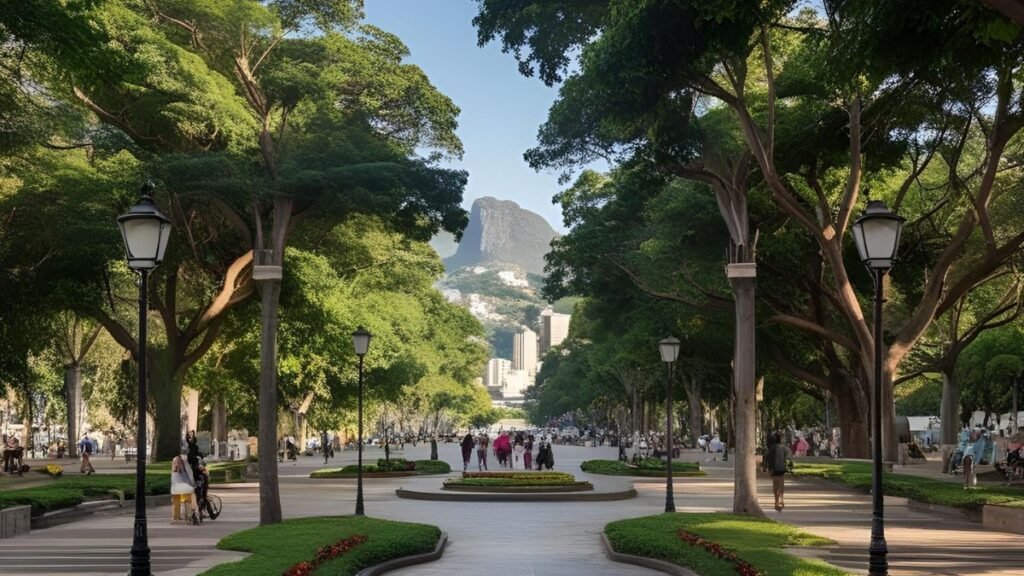
Exploring the Historic Mansion and Gardens
The centrepiece of Parque Lage is its 1920s mansion, a stunning example of Italianate architecture. The mansion’s courtyard, with the iconic Christ statue as its backdrop, has become an Instagram sensation. Surrounding the mansion are forest trails that wind through the park’s lush territory, offering a peaceful retreat for nature lovers.
Since 1975, the mansion has housed the Visual Arts School, adding a creative energy to the site. Visitors can explore the historic interiors and admire the intricate details of the building’s design. The gardens, with their manicured lawns and tropical plants, provide a perfect setting for a leisurely stroll.
Art Exhibitions and Cultural Events
Parque Lage is not just a natural wonder; it’s also a hub for art and culture. The Visual Arts School hosts regular exhibitions, showcasing works from emerging and established artists. Public workshops and art programs are also available, making it a vibrant space for creative activities.
The park has even caught the attention of the entertainment industry. It served as a filming location for music videos by Snoop Dogg and Pharrell, adding to its cultural significance. After exploring the art and nature, visitors can relax at Café do Parque, which offers alfresco dining with a view of the gardens.
“Parque Lage is where history, nature, and art come together in perfect harmony.”
| Activity | Details |
|---|---|
| Historic Mansion Tour | Explore the Italianate architecture and interiors. |
| Forest Trails | Walk through lush trails with scenic views. |
| Art Exhibitions | Visit ongoing exhibitions at the Visual Arts School. |
| Café do Parque | Enjoy alfresco dining in the gardens. |
Maracanã Stadium: A Temple of Football
Known as the heart of football passion, Maracanã Stadium stands as a symbol of the sport’s rich legacy. Built for the 1950 World Cup, this iconic venue has witnessed some of the most unforgettable moments in football history. With a capacity of 78,838, it remains a focal point for both fans and athletes.
History of Brazil’s Most Famous Stadium
The stadium’s story began in 1950 when it was constructed to host the World Cup. That year, it set a record with 199,854 spectators for the Brazil-Uruguay final, a match that remains etched in football lore. Over the decades, Maracanã Stadium has undergone significant evolution, undergoing renovations from 2010 to 2013 to modernise its facilities while preserving its historic façade in Rio de Janeiro, Brazil.
Today, the stadium is more than just a sports venue; it is a symbol of community spirit. It’s a cultural landmark that reflects the city’s love for football. Its museum showcases memorabilia from legends like Pelé and Zico, offering visitors a glimpse into the sport’s storied past.
Guided Tours and Matchday Experiences
For those looking to explore behind the scenes, guided tours provide access to locker rooms and the pitch. These VIP experiences allow fans to walk in the footsteps of their favourite players. The stadium’s vibrant atmosphere is best experienced during local derbies, such as Flamengo vs Fluminense, where the energy of the people is palpable.
Whether you’re a football enthusiast or a casual visitor, Maracanã Stadium offers an unforgettable journey into the heart of the sport. For more details on its history and events, visit the official Maracanã Stadium page.
Ipanema Beach: More Than Just a Beach
Ipanema Beach is a cultural icon that goes beyond its golden sands. Made famous by the 1964 hit “The Girl from Ipanema,” this beach is a symbol of vibrant energy and social life. It’s a place where locals and tourists alike gather to enjoy the sun, surf, and lively atmosphere.
The Vibrant Culture of Ipanema
From Arpoador to Leblon, Ipanema is divided into distinct social zones, each with its own vibe. Posto 9, known as the gay-friendly section, is a hub of inclusivity and celebration. At Pedra do Arpoador, sunset drum circles create a magical experience, drawing crowds to watch the sun dip below the horizon.
For those who love shopping, Rua Visconde de Pirajá offers a mix of luxury boutiques and local stores. After a day of exploring, head to Bar do Mineiro for a taste of traditional feijoada, a Brazilian stew that’s a local favourite.
Best Spots for Sunbathing and People-Watching
Ipanema Beach is ideal for sunbathing, boasting soft sand and crystal-clear water. The area near Posto 8 is ideal for families, while Posto 9 attracts a younger, more eclectic crowd. For a quieter experience, head to the Leblon end of the beach.
Here are some tips to make the most of your visit:
- Arrive early to secure a good spot on the sand.
- Stay hydrated and use sunscreen to protect against the strong sun.
- Be cautious with beach vendors and keep valuables secure.
Whether you’re soaking up the sun or soaking in the culture, Ipanema Beach is a place that offers something for everyone. Its unique blend of natural beauty and social energy makes it a must-visit destination.
Jardim Botânico: A Botanical Paradise
Step into a world where nature and history intertwine at Jardim Botânico. Founded in 1808, this location is home to over 6,500 plant species, including 750 majestic palm trees lining the Avenue of Royal Palms. It’s a haven for plant enthusiasts and photographers alike.
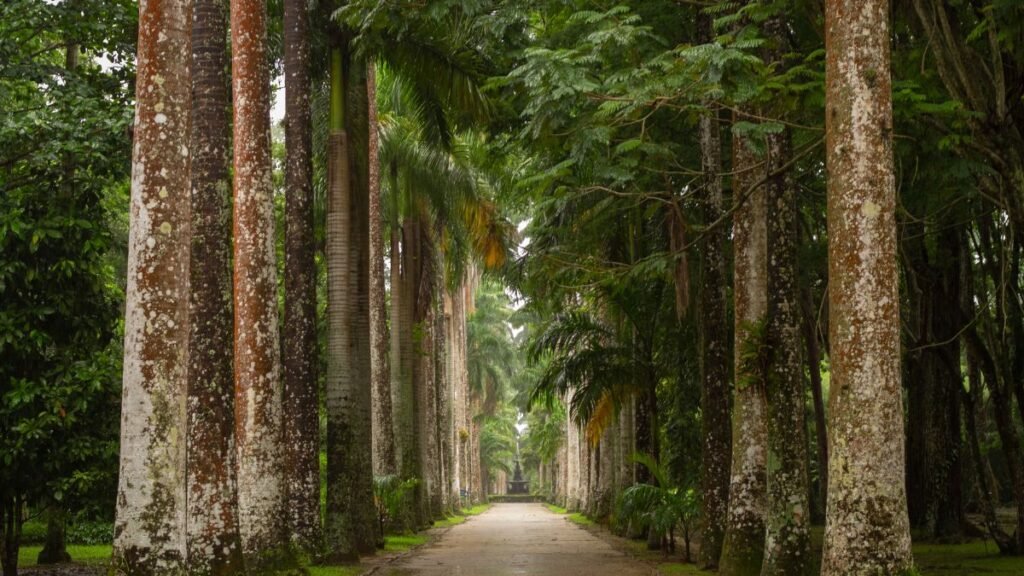
Discovering Rare Plant Species
One of the highlights is the imperial-era orchid greenhouse, a testament to the garden’s rich history. The garden also plays a vital role in conservation, with programs dedicated to protecting endangered species. Visitors can explore diverse areas, from the Japanese Garden to the serene Victoria lilies pond.
Walking Paths and Photography Opportunities
Jardim Botânico offers well-maintained walking paths that wind through its lush greenery. For photography enthusiasts, the Japanese Garden and the Victoria lilies pond are must-visit spots. Guided tours are available in multiple languages, making it easy to learn about the garden’s history and significance.
For a complete experience, consider pairing your visit with a trip to the nearby Rio Aquarium. Here’s what you can expect:
- Explore the imperial-era orchid greenhouse.
- Learn about endangered species conservation programs.
- Capture stunning photos at the Japanese Garden and Victoria lilies pond.
- Join guided tours available in multiple languages.
- Combine your visit with a trip to the Rio Aquarium.
Jardim Botânico is more than just a garden; it’s a journey through nature and history. Whether you’re a plant lover or a photography enthusiast, this national park offers an unforgettable experience.
Museu do Amanhã: The Museum of Tomorrow
Step into a museum that redefines our perspective on the future. The Museu do Amanhã, opened in 2015, is a groundbreaking institution that blends science, art, and sustainability. Designed by renowned architect Santiago Calatrava, it’s a part of the city’s revitalised waterfront and a symbol of innovation.
Exploring Futuristic Exhibits
The museum’s interactive exhibits focus on themes like climate change, artificial intelligence, and space exploration. Visitors can engage with immersive displays that challenge their understanding of the world. One highlight is the climate change exhibit, which uses real-time data to show the impact of human activity on the planet.
Temporary exhibits often feature cutting-edge topics, such as advancements in AI and the future of space travel. These displays are designed to spark curiosity and inspire visitors to think critically about the next century.
Architectural Marvel and Sustainability Focus
The building itself is a masterpiece, boasting a sleek, futuristic design and over 5,000 solar panels. The system harnesses renewable energy, contributing to the museum’s LEED Gold certification. The rooftop offers stunning views of Guanabara Bay, making it a perfect spot for photography.
After exploring the exhibits, visitors can enjoy waterfront dining at nearby Pier Mauá. The area is a vibrant part of the city, offering a mix of culture and relaxation.
“The Museum of Tomorrow is where science, art, and sustainability converge to inspire a better future.”
Lapa Arches: A Gateway to Rio’s Nightlife
Standing tall as a symbol of the city’s past and present, the Lapa Arches are a must-see landmark. This 18th-century aqueduct, with its 42 arches spanning 270 meters, was once part of a complex system designed to transport water from the Carioca River to the city centre. Today, it’s a vibrant hub of culture and energy.
Historical Significance of the Arches
The Lapa Arches have a rich history rooted in colonial ingenuity. Built in the 1700s, they were a vital part of the city’s water supply system. Over time, the structure evolved into a symbol of resilience and transformation, blending its historical roots with modern-day vibrancy.
Today, the arches serve as a backdrop to the district’s lively atmosphere. They stand as a testament to the area’s transformation from a functional aqueduct to a cultural hub.
Best Bars and Clubs in the Lapa District
The Lapa district is famous for its Friday night street samba parties. The area comes alive with music, dance, and a sense of community. Iconic venues like Rio Scenarium and Carioca da Gema offer unforgettable experiences, from live samba to eclectic DJ sets.
For a deeper dive into the district’s nightlife, check out the Lapa Arches guide. It’s a treasure trove of information on the best spots to explore.
Here are some tips for a safe and enjoyable night out:
- Stay in well-lit, crowded areas.
- Avoid displaying valuables or large amounts of cash.
- Use trusted transportation options when travelling late at night.
The Lapa district is a unique blend of historic architecture and modern clubs. Whether you’re dancing the night away or soaking in the culture, it’s an experience you won’t forget.
Barra da Tijuca: Rio’s Modern Side
Barra da Tijuca offers a refreshing contrast to the city’s historic charm. This vibrant area is renowned for its 18 km stretch of pristine beaches, upscale shopping, and contemporary lifestyle. Developed in the 1980s, it has become a hub of innovation and leisure, making it a must-visit destination for travellers seeking a modern experience.
Beaches, Shopping, and Contemporary Lifestyle
Praia do Pepê is a postcard-perfect beach that attracts both locals and tourists. Its golden sands and clear water make it ideal for sunbathing and swimming. For those who love shopping, Village Mall offers a range of luxury brands and fine dining, making it a top destination in the area.
The district’s condominiums are known for their security and exclusivity, offering a contrast to the public beaches. This blend of private and public spaces creates a unique dynamic that defines Barra da Tijuca.
Water Sports and Outdoor Activities
For adventure seekers, Reserva Beach is a hotspot for kite surfing and other water activities. The strong winds and open spaces make it perfect for thrill-seekers. The Olympic Park, built for the 2016 Games, is another highlight. Venues like the Velodrome and Tennis Centre continue to host events, adding to the district’s vibrant energy.
“Barra da Tijuca is where modernity meets coastal charm, offering something for everyone.”
- Explore Praia do Pepê for a relaxing day by the sea.
- Visit Village Mall for upscale shopping and dining.
- Try kite surfing at Reserva Beach for an adrenaline rush.
- Discover the Olympic Park’s legacy venues.
- Experience the blend of private condominiums and public spaces.
Pão de Açúcar: The Sugar Loaf Experience
A marvel of geology, Pão de Açúcar is a must-see for every traveller. This iconic sugar loaf formation, shaped over 600 million years, rises dramatically above the bay. Its name traces back to the 16th-century sugar trade, when its shape reminded settlers of the sugar moulds used in production.
History and Geology of the Iconic Landmark
Formed during the Precambrian era, Pão de Açúcar is a granite monolith that stands as a testament to Earth’s ancient history. Its unique shape, resembling a sugar loaf, has made it a defining feature of the skyline. The surrounding hills and bay create a stunning backdrop, making it a favourite among tourists and photographers alike.
Tips for a Memorable Visit
The two-stage cable car journey to the summit is an experience in itself. The first stop at Morro da Urca offers panoramic views, while the second takes you to the top of the Sugarloaf. For the best experience, visit during twilight to witness the city lights come alive.
Adventure seekers can explore rock climbing routes on the granite hills. These routes cater to experienced climbers, offering both challenge and reward. Combined tickets are available, allowing access to nearby museums and attractions.
Wildlife enthusiasts will enjoy spotting marmosets and other native species. The site is a haven for nature lovers, offering a blend of adventure and tranquillity. Whether you’re climbing, sightseeing, or simply soaking in the views, Pão de Açúcar promises an unforgettable experience.
Copacabana Fort: A Historical Landmark
Overlooking the iconic shoreline, Copacabana Fort stands as a testament to the city’s rich past. Built in 1914, this fort has played a vital role in coastal defence, blending military history with stunning views of Copacabana Beach. Today, it’s a must-visit for those seeking a deeper connection to the city’s heritage.
Military History and Exhibits
The fort’s strategic location made it a key player in both World Wars. Its 380mm Krupp cannons, once used for coastal defence, are now part of the Army History Museum’s collection. Visitors can explore exhibits showcasing the fort’s role in safeguarding the city and its evolution over the decades.
One of the highlights is the Sunday cannon firing tradition, a nod to its military roots. The museum also features artefacts, uniforms, and detailed accounts of the fort’s contributions to World War I and World War II. It’s a fascinating journey through time for history enthusiasts.
Stunning Views of Copacabana Beach
Beyond its historical significance, the fort offers panoramic views of Copacabana Beach and the surrounding coastline. It’s a perfect spot for photography, especially when framing Sugarloaf Mountain in the background. Early mornings or late afternoons provide the best lighting for capturing the scenery.
After exploring, head to Café do Forte for a seaside brunch. The café’s relaxed atmosphere and delicious menu make it a favourite among visitors. Whether you’re soaking in the views or enjoying a meal, the fort is a place where history and beauty converge.
| Activity | Details |
|---|---|
| Army History Museum | Explore exhibits on military history and artifacts. |
| Sunday Cannon Firing | Witness the traditional cannon firing ceremony. |
| Café do Forte | Enjoy a seaside brunch with stunning views. |
| Photography Tips | Capture Sugarloaf Mountain and the coastline. |
Conclusion: Exploring Rio de Janeiro, Brazil, Beyond the Beaches
Beyond its famous shoreline, this vibrant destination offers a mix of urban energy and natural wonders. From the lush trails of Tijuca National Park to the historic streets of Santa Teresa, the city is a treasure trove of experiences waiting to be explored.
To truly immerse yourself in the local culture, venture beyond the tourist hotspots. Engage with the arts in Santa Teresa, savour traditional cuisine, and join the lively samba nights in Lapa. These experiences provide a deeper connection to the world of this dynamic destination.
For a well-rounded trip, consider a 7-day itinerary covering iconic landmarks like Christ the Redeemer and hidden gems like Parque Lage. Plan your visit around seasonal events, such as Carnival, or enjoy quieter moments during the offseason.
Lastly, practice responsible tourism by supporting local businesses and respecting the environment. This ensures that the beaches and cultural landmarks remain vibrant for future generations to enjoy. Whether you’re a first-time visitor or a returning traveller, there’s always something new to discover. Learn more Irresistible Brazilian Food.
FAQ
What makes Christ the Redeemer a must-see attraction?
The iconic statue offers breathtaking views and symbolises the city’s rich culture and history. It’s a UNESCO World Heritage Site and a spiritual landmark.
When is the best time to visit Tijuca National Park?
Early mornings or weekdays are ideal to avoid crowds. The park’s trails and wildlife are best enjoyed during the dry season, from May to October.
How do I get to the top of Sugarloaf Mountain?
Take the cable car from Praia Vermelha. The two-stage ride provides stunning panoramic views of the bay and surrounding areas.
What makes Santa Teresa unique?
Known for its bohemian vibe, this neighbourhood features cobblestone streets, vibrant art galleries, and charming cafes that showcase the city’s creative spirit.
What can I expect at Parque Lage?
This historic site offers lush gardens, a picturesque mansion, and art exhibitions. It’s a peaceful retreat in the heart of the city.
Is Maracanã Stadium worth visiting?
Absolutely. As one of the world’s most famous football stadiums, it offers guided tours and provides an opportunity to experience Brazil’s passion for the sport.
What activities can I enjoy at Ipanema Beach?
Besides sunbathing, you can explore local markets, enjoy live music, and experience the vibrant culture that makes this beach a favourite.
What’s special about Jardim Botânico?
This botanical garden is home to rare plant species, walking paths, and stunning photo opportunities, making it a haven for nature lovers.
What does Museu do Amanhã focus on?
The museum explores futuristic themes, sustainability, and innovation through interactive exhibits and its striking modern architecture.
Why visit the Lapa Arches?
This historic aqueduct serves as a gateway to the lively Lapa district, renowned for its vibrant nightlife, samba clubs, and distinctive street culture.

